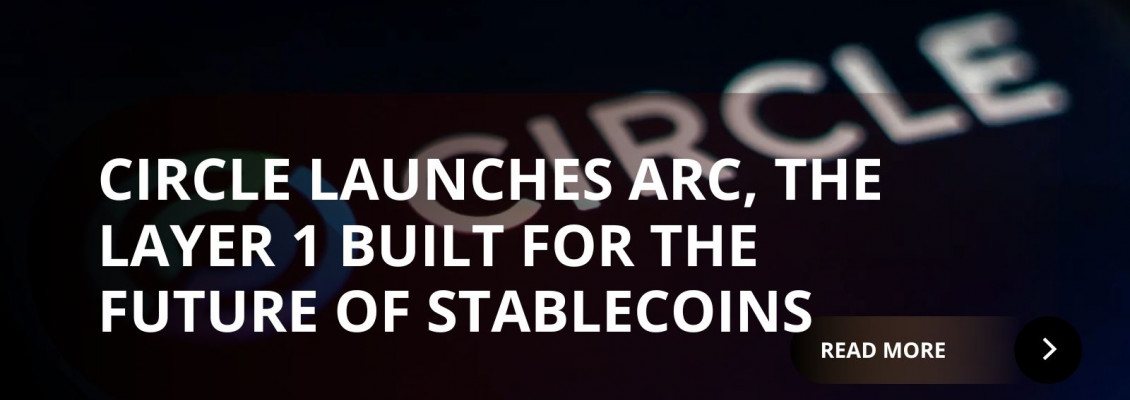
Circle’s Arc Could Be the Breakthrough Blockchain Has Been Waiting For
Circle, the company behind the USD Coin (USDC) stablecoin, has unveiled Arc, an open Layer 1 blockchain designed specifically for stablecoin finance. This move isn’t just another blockchain launch — it’s a signal that crypto infrastructure is maturing and evolving toward real-world use cases that matter: payments, tokenisation, and global financial connectivity.
A Layer 1 Built for the Real Economy
Arc is engineered from the ground up to power stablecoin transactions and on-chain finance with speed, predictability, and regulatory readiness.
Here’s what makes it stand out:
-
USDC as gas: Arc uses USDC as its native gas token, so fees are stable and predictable. No more dealing with volatile gas prices in native tokens.
-
EVM compatible: Developers can build using familiar Ethereum tools, making migration and integration easy.
-
Enterprise ready: Arc offers sub-second settlement times, privacy-optional transactions, and infrastructure that supports large-scale, compliant use cases.
-
On-chain FX and settlement: A built-in foreign exchange engine enables seamless conversion between stablecoins and tokenised assets.
In essence, Arc aims to serve as the “settlement layer” for digital dollars, tokenised securities, and other real-world assets. This is where blockchain moves from speculation to real utility.
Institutions Are Paying Attention
Arc isn’t launching into a vacuum — it’s already attracting interest from some of the biggest names in finance and technology. BlackRock, Visa, and Anthropic are reportedly participating in its public testnet, and over 100 institutions are expected to onboard through Circle’s ecosystem.
The blockchain will also launch with Fireblocks support from day one, giving banks, asset managers, and fintechs enterprise-grade custody and tokenisation tools immediately.
This level of institutional engagement marks an important milestone for crypto. For years, traditional finance has tested blockchain in controlled pilots. Now, with Arc, we’re seeing real deployment at scale.
The Next Step in Stablecoin Evolution
Stablecoins are becoming the bridge between traditional finance and crypto. USDC alone has grown more than 90 percent year over year, reaching over 61 billion dollars in circulation.
Arc positions Circle to lead the next phase of that growth. Instead of depending solely on third-party chains, Circle is building a dedicated network optimised for compliance, speed, and interoperability. By doing this, Circle strengthens the entire crypto ecosystem — offering a foundation for payments, DeFi, and tokenised assets that regulators and enterprises can trust.
This is exactly the kind of infrastructure crypto has needed to move beyond speculation and into mainstream adoption.
Why Arc Matters for the Blockchain Industry
Arc represents a clear vote of confidence in blockchain’s long-term potential. It shows that crypto companies are not just launching new tokens or apps — they’re building the next-generation financial rails.
A growing number of global financial and technology leaders are exploring Arc, Circle’s new blockchain network. Traditional finance heavyweights such as State Street, Deutsche Bank, Invesco, and Société Générale are among the participants, alongside digital asset pioneers like Coinbase and Kraken, fintech innovators Nuvei and Brex, and global tech providers AWS and Mastercard.
Visa is using the Arc testnet to explore how stablecoin-backed payment infrastructure could accelerate cross-border money movement. BlackRock’s head of digital assets, Robert Mitchnick, said the firm is examining how Arc’s built-in support for stablecoin settlement and on-chain FX could “unlock additional utility” for capital markets.
Invesco is studying how blockchain can make tokenized funds more efficient, while Société Générale is testing programmable settlement and enhanced transparency for cross-border capital flows. HSBC, one of the world’s largest banks, is assessing Arc’s potential to deliver faster and more transparent international payments.
State Street is focused on digital asset custody integrations, and SBI Holdings is evaluating how regulated financial services might extend into on-chain environments. Deutsche Bank, Standard Chartered, and First Abu Dhabi Bank are also participating, highlighting the growing interest from major global banking networks in blockchain-based settlement infrastructure.
A Positive Signal for Crypto’s Future
Yes, there are risks. Governance, adoption, and regulatory clarity will shape Arc’s success. But the overall direction is undeniably positive.
Circle’s decision to build Arc demonstrates confidence in blockchain’s staying power. It’s a statement that crypto isn’t just here to disrupt — it’s here to rebuild finance from the ground up, better, faster, and more connected than ever.
Final Take
Arc could mark the beginning of a new chapter for blockchain. By combining stablecoin stability, institutional trust, and modern chain design, Circle is creating a system that brings crypto closer to the real economy.
If Arc’s testnet launch in fall 2025 delivers on its promise, it won’t just be a milestone for Circle — it will be a breakthrough moment for the entire blockchain and crypto industry.
Stay Connected
You can stay up to date on all News, Events, and Marketing of Rare Network, including Rare Evo: America’s Premier Blockchain Conference, happening July 28th-31st, 2026 at The ARIA Resort & Casino, by following our socials on X, LinkedIn, and YouTube.

Leave a Comment